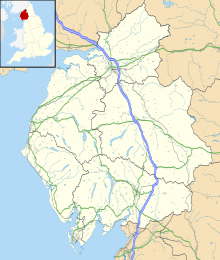RAF Cark
RAF Cark | |||||||||||||||||||
|---|---|---|---|---|---|---|---|---|---|---|---|---|---|---|---|---|---|---|---|
| Summary | |||||||||||||||||||
| Airport type | Military | ||||||||||||||||||
| Owner | Air Ministry | ||||||||||||||||||
| Operator | Royal Air Force | ||||||||||||||||||
| Location | Cark, Lancashire | ||||||||||||||||||
| Built | 1941 | ||||||||||||||||||
| In use | 1941-1945 | ||||||||||||||||||
| Elevation AMSL | 17 ft / 5 m | ||||||||||||||||||
| Coordinates | 54°09′45″N 002°57′30″W / 54.16250°N 2.95833°WCoordinates: 54°09′45″N 002°57′30″W / 54.16250°N 2.95833°W | ||||||||||||||||||
| Map | |||||||||||||||||||
 RAF Cark Location in South Lakeland | |||||||||||||||||||
| Runways | |||||||||||||||||||
| |||||||||||||||||||
Royal Air Force Cark or more simply RAF Cark is a former Royal Air Force station in the county of Cumbria (formerly Lancashire) which was operational between 1941 and 1945. It was built near the villages of Cark and Flookburgh[1] on the Cartmel Peninsula which today forms part of Cumbria.[3]
History[]
Construction[]
RAF Cark was constructed on a site which had been considered for a possible airship factory in 1916. Preparation work had been undertaken however the project was cancelled the following year.[4]
Operational life[]
Opening in 1941, the station was designed primarily to operate as a fighter station under the control of RAF Fighter Command in order to afford protection to the industrialised areas of northwest England.[3]
The airfield featured a dispersal site on the east side which consisted of six pens each able to accommodate two aircraft. On the northwest side of the airfield a Bellman Hangar was built on the technical site and in time this was supplemented by the addition of fourteen blister type hangars.[3]
Once the threat of invasion had receded, the airfield was used by RAF Flying Training Command as a Staff Pilot Training Unit and for Anti Aircraft gunnery training with aircraft such as Hawker Hurricanes, Miles Martinets and latterly Supermarine Spitfires.
Initially parented by RAF Millom, RAF Cark became a self reliant station during 1942. The Staff Pilot Training Unit left in November 1942, but returned the following March. In 1944 gliders of the requisitioned Lakes Gliding Club were moved from RAF Walney and formed No. 188 Gliding School, Air Training Corps.
During its operational life RAF Cark played host to detachments from several squadrons on anti aircraft co-operational duties.

Units[]
During the course of the operation of the station, the following units were at sometime based at RAF Cark:[3]
03/41 to 11/42, .
01/42 to 10/42, No. 1 Anti-Aircraft Co-operation Unit RAF ('R'.Flt).
01/42 to 11/42, No. 1 Anti-Aircraft Co-operation Unit RAF ('F'.Flt).
03/42 to 03/43, No. 6 Anti-Aircraft Co-operation Unit RAF
11/42 to 12/43, No. 1614 (Anti-Aircraft Co-operation) Flight RAF.
11/42 to --/--, No. 289 Squadron RAF (detachment) with Hawker Hurricanes.
03/43 to 12/45, Staff Pilot Training Unit.
03/43 to 11/44, No. 650 Squadron RAF (detachment) with Miles Martinets.
04/44 to 05/44, No. 290 Squadron RAF (detachment) with Supermarine Spitfires
11/44 to --/--, 650 Sqn (detachment) with Hawker Hurricanes.
10/45 to 12/45, Pilot-Navigation Instructors Course RAF
--/44 to 05/47, No. 188 Gliding School, Air Training Corps.
Closure[]
Following the cessation of hostilities in 1945 operations at RAF Cark were run down with the station being placed on care and maintenance.[1] The last residents to leave were No. 188 Gliding School who transferred to RAF Walney in May 1947 following which the Station closed.[4][1]
Subsequent use[]
RAF Cark was sold off by the Air Ministry and was subsequently used as a venue for gliding. Today, Cark Airfield is the home of the North West Parachute Centre.[3]
See also[]
References[]
Citations[]
- ^ a b c d "RAF Cark". Control Towers. Retrieved 16 March 2018.
- ^ "Cark (Flookburgh)". Airfields of Britain Conservation Trust. Retrieved 14 May 2020.
- ^ a b c d e "Cark". RonaldV. Retrieved 16 March 2018.
- ^ a b "Cark". Archived from the original on 21 April 2017.
External links[]
- Royal Air Force stations in Cumbria
- Royal Air Force stations of World War II in the United Kingdom
- Royal Air Force stations in Lancashire
- Military units and formations established in 1941
- South Lakeland District
- Military units and formations disestablished in 1947


